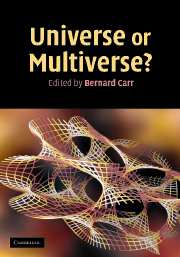Book contents
- Frontmatter
- Contents
- List of contributors
- Preface
- Acknowledgements
- Editorial note
- Part I Overviews
- Part II Cosmology and astrophysics
- Part III Particle physics and quantum theory
- 14 Quarks, electrons and atoms in closely related universes
- 15 The fine-tuning problems of particle physics and anthropic mechanisms
- 16 The anthropic landscape of string theory
- 17 Cosmology and the many worlds interpretation of quantum mechanics
- 18 Anthropic reasoning and quantum cosmology
- 19 Micro-anthropic principle for quantum theory
- Part IV More general philosophical issues
- Index
- References
15 - The fine-tuning problems of particle physics and anthropic mechanisms
Published online by Cambridge University Press: 05 July 2014
- Frontmatter
- Contents
- List of contributors
- Preface
- Acknowledgements
- Editorial note
- Part I Overviews
- Part II Cosmology and astrophysics
- Part III Particle physics and quantum theory
- 14 Quarks, electrons and atoms in closely related universes
- 15 The fine-tuning problems of particle physics and anthropic mechanisms
- 16 The anthropic landscape of string theory
- 17 Cosmology and the many worlds interpretation of quantum mechanics
- 18 Anthropic reasoning and quantum cosmology
- 19 Micro-anthropic principle for quantum theory
- Part IV More general philosophical issues
- Index
- References
Summary
Open questions in particle physics
Each field has a set of questions which are universally viewed as important, and these questions motivate much of the work in the field. In particle physics, several of these questions are directly related to experimental problems. Examples include questions such as: Does the Higgs boson exist and, if so, what is its mass? What is the nature of the dark matter in the Universe? What is the mechanism that generated the net number of baryons in the Universe? For these topics, there is a well posed problem related to experimental findings or theoretical predictions. These are problems that must be solved if we are to achieve a complete understanding of the fundamental theory.
There also exists a different set of questions which have a more aesthetic character. In these cases, it is not as clear that a resolution is required, yet the problems motivate a search for certain classes of theories. Examples of these are the three ‘naturalness’ or ‘fine-tuning’ problems of the Standard Model; these are associated with the cosmological constant Λ, the energy scale of electroweak symmetry-breaking ν and the strong CP-violating angle θ. As will be explained more fully below, these are free parameters in the Standard Model that seem to have values 10 to 120 orders of magnitude smaller than their natural values and smaller than the magnitude of their quantum corrections.
- Type
- Chapter
- Information
- Universe or Multiverse? , pp. 231 - 246Publisher: Cambridge University PressPrint publication year: 2007
References
- 13
- Cited by



